Viola Spolin’s house is in danger of being sold and perhaps demolished.
Why does this matter?
I would nominate Viola Spolin and Hallie Flanagan as the two most important women in the history of American theatre. (If you don’t know Flanagan, she was the most prolific producer in American theatrical history. Cherry Jones once played her in a movie.)
Spolin created theatre games. She also was the mother of Paul Sills, who co-founded Second City and created the story theatre format. Between the two of them, they launched the improvisational theatre movement that transformed American theatre, film, and TV. Other major teachers came along: Del Close. Martin da Maat. Mick Napier. Gary Austin. Charna Halpern. Susan Messing. Sheldon Patinkin. Michael Gellman. All major figures. And most told me (sometimes grouchily) that Viola laid the foundations of their work. In the beginning was absolutely Viola.
I can trot out a list of improv alumni currently on the scene, if you like, all of whom cite Spolin’s formative work: Tina Fey, Stephen Colbert, Adam McKay, Seth Myers, Keegan-Michael Key, Julia Louis-Dreyfus, Jordan Peele, Steve Carell, Kate McKinnon, Martin Short, Andrea Martin, Amy Poehler. (Yup, a lot of “SNL” names—young Lorne Michaels used to hang out at the Canadian Second City and hired from there a lot.) If you want to confine the list just to those directly taught or influenced by her, it’s a pretty impressive too: Severn Darden, Barbara Harris, Alan Arkin, Alan Alda, Roger Bowen, Avery Schreiber, Mike Nichols, Elaine May, Valerie Harper, Richard Schaal, Paul Sand.
Viola lived in a house in the Santa Monica Mountains, near the Cahuenga Pass in Los Angeles. She wrote some of her groundbreaking books there, including Improvisation for the Theater, which Rob Reiner has called “the bible.” (Reiner was another improviser.) Paul Sills, his wife Carol, and their children (including Aretha Sills, another master teacher) spent decades there, theorizing, bullshitting, experimenting, refusing to take the frequent opportunities offered to get rich. (I mean, you’ve got to stand for something, right?)
Very noble, the refusal to cash in. Except this makes the house vulnerable. The funds just aren’t there to keep it from being put up for sale.
This country has a woeful record of preserving valuable stuff. A few theatrical landmarks have managed to escape oblivion. The O’Neill Center owns and administers Monte Cristo Cottage, the scene of Eugene O’Neill’s boyhood and the settings of Long Day’s Journey Into Night and Ah, Wilderness! Ten Chimneys, the mansion that Alfred Lunt and Lynn Fontanne called home in Wisconsin, hosts a variety of theatrical programs. And Ford’s Theatre in Washington, D.C., site of Abraham Lincoln’s assassination, is owned and managed by the National Park Service and still is operated as a venue.
But these are all sites associated with scripted, “legit” theatre. Comedy is rarely accorded the respect that the more serious stuff is, so many of the landmarks of improvisational theatre are gone: The original site of the Compass Players, birthplace of professional improvisation in America; the original Second City, which opened its doors in 1959 (doors that were knocked down by developers putting up a high rise); the Crystal Palace where, legend has it, Elaine May, Theodore Flicker, and Del Close used the stage to test new principles for improv they generated to survive in front of St. Louis audiences. All gone.
But for now Viola Spolin’s house still stands.

I visited the house once, in the 1970s, when I went there to interview Viola for a book I was writing about the origins of Second City. We had a conversation in which she gently suggested that I was a foolish boy not equal to the task, but gave me wonderful quotes anyway. And then she abruptly decided not to sign the release, so I couldn’t publish the conversation.
“Viola,” I asked, “why?”
“Oh, honey,” she said. “People have been making money off of my ideas for years and I’ve decided to draw the line.”
I replied, “You’re drawing the line in the wrong place. I guarantee you I won’t make any serious money off this book.”
“I’m sorry, my mind is made up.”
And so her interview did not appear in my book, Something Wonderful Right Away. The last time I saw her was sometime in the ’80s, after a performance of Sills and Company, an evening in which many of the great improvisers of the day played her games in front of enraptured audiences. (Tom Viertel later brought the offering to New York for an extended run off-Broadway.) She spotted me, swooped over and threw her arms around me, and said, “Oh, darling, do you hate me?” I told her that her work had made much of what I love in the theatre possible—and no, of course, I didn’t hate her. And she scurried away.
Some years later, after she died in 1994, I wrote an article about her for a magazine called Dramatics. The editor put her picture on the cover. Carol Sills told me that Viola would have been thrilled to be a cover girl. And, as executor of the estate, Carol said that if I ever put together a new edition of Something Wonderful Right Away, I have permission to finally include my conversation with Viola in the book. One of these days that will happen.
In the meantime, there’s this house. A house that was expanded around her as she needed more room. A house that has in its bones the echoes of a genuine American genius. A house at 6923 Woody Trail that needs someone to rescue and preserve it.
Who knows somebody who can make that happen?
Jeffrey Sweet is a writer based in New York.


